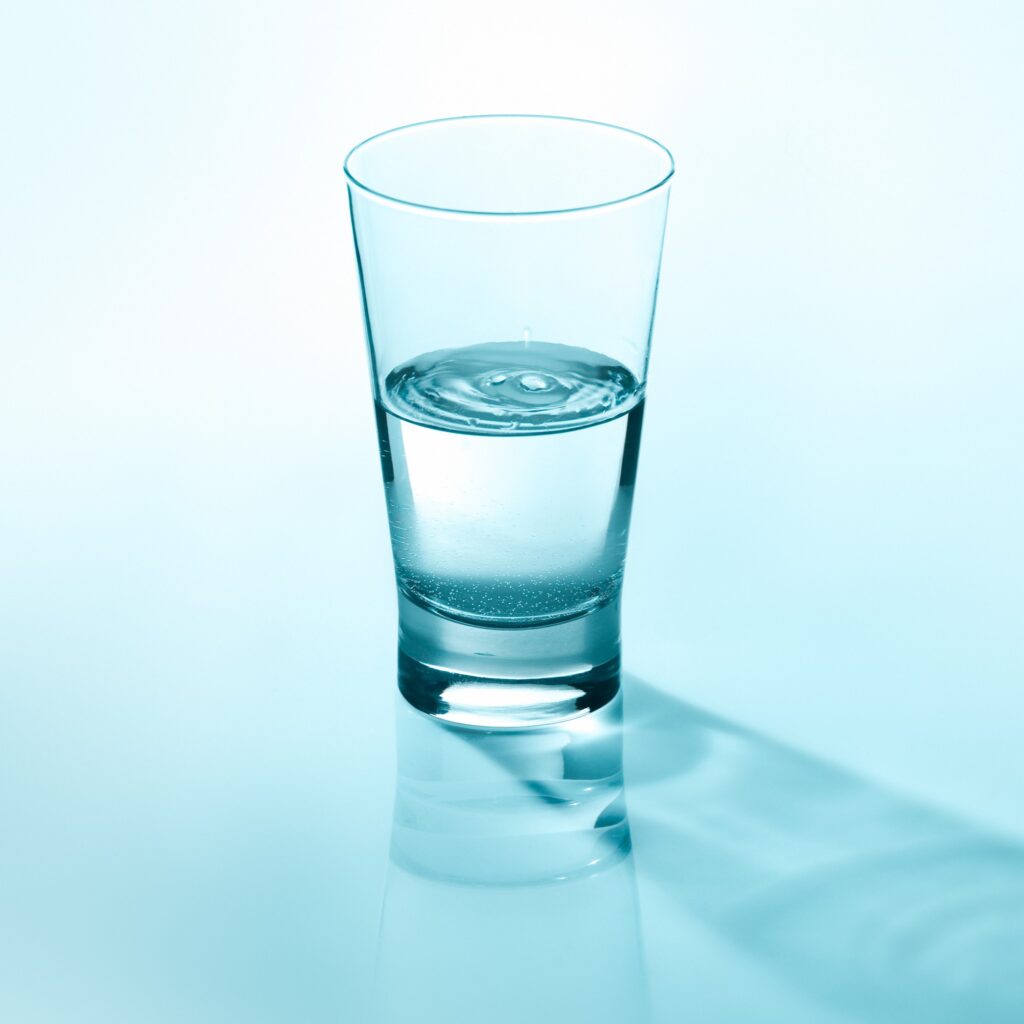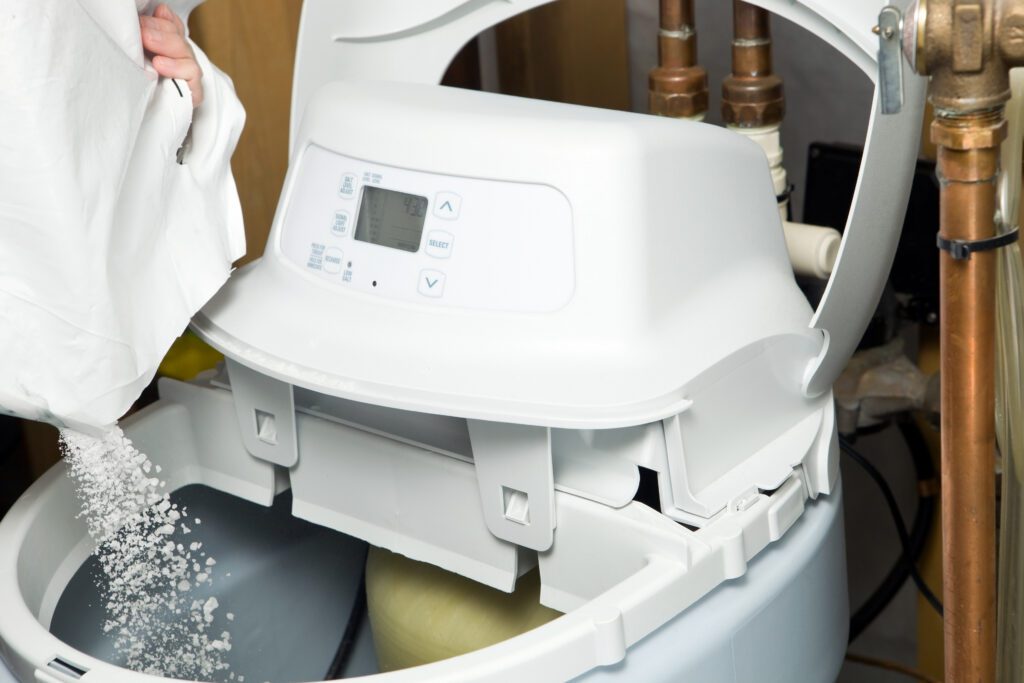Understanding hard water and the role of water softening
Water hardness refers to the amount of calcium and magnesium compounds dissolved in water. These minerals naturally occur in groundwater and are not harmful to human health. In the Madison area, our drinking water source is groundwater that’s high in minerals, creating hard water. Water softeners that use softener salt are the most common treatment for hard water in our area, but there are ways to minimize salt use and reduce chloride pollution.
Impacts of hard water
Hard water can cause buildup, called scale, on fixtures and appliances which can reduce water flow and appliance efficiency. Scale forms more easily in hot water than in cold water, and is particularly observed in water heaters and appliances that use hot water. For example, scale can make water heaters less efficient by creating a barrier between the heating element and the water. Depending on the type of water heater, scale buildup can decrease its lifespan or increase its energy use because it has to work harder to heat water. Hardness can also leave deposits on clothing and dishes after washing that some people find undesirable. And, hard water can cause soap scum and inhibit soap lathering due to the way hardness particles interact with soap.

The hardness level of water is classified based on the concentration of total calcium carbonate (CaCO3). This concentration can be expressed as milligrams per liter (mg/L) or grains per gallon (gpg), which is the unit commonly used when talking about water softeners. According to the USGS, the levels of water hardness correspond with the following CaCO3 concentrations:
- Soft: 0-60 mg/L or 0-3.5 gpg
- Moderately hard: 61-120 mg/L or 3.5-7 gpg
- Hard: 121-180 mg/L or 7-10.5 gpg
- Very hard: more than 180 mg/L or more than 10.5 gpg
Generally, the higher the hardness, the more potential for noticeable impacts of hard water. In the Madison area, drinking water ranges from 15 to 32 gpg depending on the source well, classifying all drinking water as “very hard.” View our water hardness map.
Softening or conditioning water can reduce or prevent scale buildup and other hard water impacts.
- Water softening is the process of removing hardness particles from a building’s source water so the water used in the building is soft (containing very little to no hardness).
- Water conditioning is the process of changing the nature of hardness particles in the water to reduce their tendency to form buildup. Conditioned water still contains hardness and may leave behind buildup, but this buildup isn’t as stubborn as scale from unconditioned hard water so it can be cleaned more easily. The District doesn’t have much information about how well salt-free water conditioners work in our area.
- Some cleaning products and techniques can remove scale after it has formed. Scale can be dissolved with acidic cleaners like vinegar and lemon juice.
softener salt

Water softening appliances, or water softeners, are installed where hard source water enters a building. Depending on how the building is plumbed, the water softener may treat only the water heading to the water heater (hot-only softening), or it may treat cold water as well as hot water. Softeners remove calcium and magnesium particles by replacing them with sodium, which is supplied by the salt in the brine tank. After softening, hardness particles are left behind in the softener, while the sodium flows in the softened water to the building.
Without the sodium from salt (sodium chloride or NaCl), softeners can’t remove hardness. When the available sodium in the softener tank is almost used up, the softener needs to regenerate to continue providing softened water. Regeneration is the process of flushing out the hardness particles from a softener and replenishing the sodium ions in the softening tank. During regeneration, the softener creates a brine solution from the salt in the brine tank and draws the solution into the softening tank, flushing out the hardness particles and leaving a fresh supply of sodium to restart the softening process. The water rinsed out of the softener during regeneration contains the removed hardness particles and chloride from the salt brine. This rinsewater goes down the drain into the sewer system and to the local wastewater treatment plant.
Most wastewater treatment plants, including the Nine Springs Wastewater Treatment Plant, are not designed to remove chloride dissolved in water. Every bag of salt used by a water softener travels through the treatment process and flows into a local freshwater stream. Too much chloride threatens freshwater life, so the District is working to reduce the amount of softener salt used in our community, before it arrives to the plant.
Pros and Cons of Softeners
Softening water has advantages and disadvantages. There is no requirement to have a softener in a home; it’s up to the individual homeowner to decide whether they want to soften their water, and if so, how much they want to soften.
Advantages of softening
- Prevents scale buildup in water heaters and other appliances, which can save energy and prolong their lifespans
- Helps soap and detergent work more effectively
- Prevents mineral residue on dishes and clothing
Disadvantages of softening
- Contributes chloride to the environment that threatens freshwater
- Requires replenishing the softener with heavy salt bags
- Leaves water feeling “slippery,” which some people don’t prefer
- May lead to steep increases in sewer bills if wastewater treatment plants need to install technology to remove chloride
So, water softeners can have energy-saving and aesthetic benefits in homes, but they can pollute water and put communities in the position of having to add expensive, energy-intensive chloride treatment technology. We recommend that residents and businesses use the lowest amount of salt possible to soften water. Salt reduction can be achieved by increasing the efficiency of your water softener or softening less water.
Water Hardness Recommendations
There’s not a one-size-fits-all level of water hardness that works for every situation. One person might want softer water, while another person might tolerate or even prefer some hardness in their water. There are also some water systems that are more sensitive to hard water, such as industrial heating and cooling systems or some medical equipment. For residential water uses, plumbing systems and appliances will function properly with water that is slightly to moderately hard. You can use a blending valve with your water softener to adjust the hardness of your home’s water to your preference.
Considerations for determining the right level of water hardness:
- A low level of hardness (3-4 gpg) can protect your water heater by forming a thin level of insulating scale on the heating element, reducing the potential for corrosion.
- A moderate hardness level of 3.5-7 gpg is considered ideal by the U.S. Department of Energy.
- Lake Michigan has a natural hardness of about 7.5-8 gpg. While this is borderline hard water, many residences in Milwaukee and other communities that get their water from Lake Michigan do not have water softeners.
- Water over a certain level of hardness may void the warranty for your water heater or other appliances. Check your appliances’ warranties to see if there is a maximum allowable water hardness to keep these products under warranty.
- The less water you soften, the less softener salt you use. If you use a blending valve or soften only the hot water in your house, you’ll save on salt and help protect freshwater from chloride pollution.







